Jersey
Jersey (/ˈdʒɜːrzi/ JUR-zee, French: [ʒɛʁzɛ] (![]() listen); Jèrriais: Jèrri [dʒɛri]), officially the Bailiwick of Jersey (French: Bailliage de Jersey; Jèrriais: Bailliage dé Jèrri), is an island and British Crown Dependency[10] near the coast of Normandy, France.[11] It is the second-closest of the Channel Islands to France, after Alderney. Jersey was part of the Duchy of Normandy, whose dukes went on to become kings of England from 1066. After Normandy was lost by the kings of England in the 13th century, and the ducal title surrendered to France, Jersey and the other Channel Islands remained attached to the English Crown.
listen); Jèrriais: Jèrri [dʒɛri]), officially the Bailiwick of Jersey (French: Bailliage de Jersey; Jèrriais: Bailliage dé Jèrri), is an island and British Crown Dependency[10] near the coast of Normandy, France.[11] It is the second-closest of the Channel Islands to France, after Alderney. Jersey was part of the Duchy of Normandy, whose dukes went on to become kings of England from 1066. After Normandy was lost by the kings of England in the 13th century, and the ducal title surrendered to France, Jersey and the other Channel Islands remained attached to the English Crown.
Bailiwick of Jersey | |
|---|---|
| Motto: | |
| Anthem: "God Save the Queen" | |
| Regional anthem: "Island Home"[1] | |
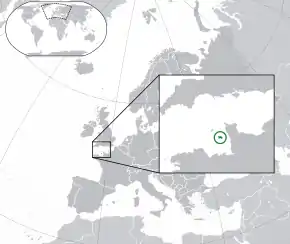 | |
| Sovereign state | United Kingdom |
| Separation from the Duchy of Normandy | 1204 |
| Capital and largest parish [lower-alpha 1] | Saint Helier [lower-alpha 2] 49°11.4′N 2°6.6′W |
| Official languages | English, Jèrriais and French[lower-alpha 3] |
| Common languages | Portuguese and Polish |
| Ethnic groups (2011) | 46.4% Jersey 32.7% British 8.2% Portuguese 3.3% Polish 2.4% Irish 0.9% French 3.8% Other European 1.3% Asian 0.4% African 0.7% multiracial[2] |
| Religion (2015)[3] | 39% non-religious 2% Other religion |
| Demonym(s) | Islanders, Jerseyman, Jerseywoman |
| Government | Parliamentary democratic constitutional monarchy |
• Monarch | Elizabeth II |
| Stephen Dalton | |
• Bailiff | Tim Le Cocq[4] |
| John Le Fondré Jr | |
| Legislature | States Assembly |
| Area | |
• Total | 118.2[5] km2 (45.6 sq mi) (unranked) |
• Water (%) | 0 |
| Highest elevation | 469 ft (143 m) |
| Population | |
• 2019 estimate | 107,800[6] (196th) |
• Density | 912/km2 (2,362.1/sq mi) |
| GDP (PPP) | 2015 estimate |
• Total | $6.0 billion (£4.57 billion)[7] (not ranked) |
• Per capita | $60,000 (£45,783) (not ranked) |
| GDP (nominal) | 2019 estimate |
• Total | £4.885 billion [8] |
• Per capita | £45,320 |
| HDI (2008) | very high · not ranked |
| Currency | Pound sterling Jersey pound (£) (GBP) |
| Time zone | UTC±00:00 (GMT) |
| UTC+01:00 (BST) | |
| Date format | dd/mm/yyyy |
| Mains electricity | 230 V–50 Hz |
| Driving side | left |
| Calling code | +44 |
| UK postcode | |
| ISO 3166 code | JE |
| Internet TLD | .je |
The Bailiwick consists of the Island of Jersey, the largest of the Channel Islands, along with surrounding uninhabited islands and rocks collectively named Les Dirouilles,[12] Les Écréhous,[12] Les Minquiers,[13] Les Pierres de Lecq,[14] and other reefs. Although the Bailiwicks of Jersey and Guernsey are often referred to collectively as the Channel Islands, the "Channel Islands" are not a constitutional or political unit. Jersey has a separate relationship to the Crown from the other Crown dependencies of Guernsey and the Isle of Man, although all are held by the monarch of the United Kingdom.[15]
Jersey is a self-governing parliamentary democracy under a constitutional monarchy, with its own financial, legal and judicial systems,[6] and the power of self-determination.[16] The Lieutenant Governor on the island is the personal representative of the Queen. Jersey is not part of the United Kingdom,[17] and has an international identity separate from that of the UK,[18] but the UK is constitutionally responsible for the defence of Jersey.[19] Unlike the UK, Jersey was never part of the European Union, however Brexit still had an impact on Jersey's relationship with Europe.[20]
British cultural influence on the island is evident in its use of English as the main language and the British pound as its primary currency, even if some people still speak or understand Jèrriais, the local form of the Norman language, and place names with French or Norman origins abound. Additional British cultural commonalities include driving on the left, access to the BBC and ITV regions, a school curriculum following that of England, and the popularity of British sports, including cricket.[21][22]
Toponymy
Origin of the name
The Channel Islands are mentioned in the Antonine Itinerary as the following: Sarnia, Caesarea, Barsa, Silia and Andium, but Jersey cannot be identified specifically because none corresponds directly to the present names.[23] The name Caesarea has been used as the Latin name for Jersey (also in its French version Césarée) since William Camden's Britannia,[24] and is used in titles of associations and institutions today. The Latin name Caesarea was also applied to the colony of New Jersey as Nova Caesarea.[25][26]
Andium, Agna and Augia were used in antiquity.
Scholars variously surmise that Jersey and Jèrri derive from jarð (Old Norse for "earth") or jarl (earl), or perhaps a personal name, Geirr ("Geirr's Island").[27] The ending -ey denotes an island[28][29] (as in Guernsey or Surtsey).
History
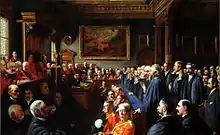
Jersey history is influenced by its strategic location between the northern coast of France and the southern coast of England; the island's recorded history extends over a thousand years.
La Cotte de St Brelade is a Palaeolithic site inhabited before rising sea levels transformed Jersey into an island. Jersey was a centre of Neolithic activity, as demonstrated by the concentration of dolmens. Evidence of Bronze Age and early Iron Age settlements can be found in many locations around the island.
Additional archaeological evidence of Roman influence has been found, in particular at Les Landes, the coastal headland site at Le Pinacle, where remains of a primitive structure are attributed to Gallo-Roman temple worship (fanum).[30]
Jersey was part of Neustria with the same Gallo-Frankish population as the continental mainland. Jersey, the whole Channel Islands and the Cotentin peninsula (probably with the Avranchin) came formally under the control of the Duke of Brittany during the Viking invasions, because the king of the Franks was unable to defend them, however they remained in the archbishopric of Rouen. Jersey was invaded by Vikings in the 9th century. In 933 it was annexed to the future Duchy of Normandy, together with the other Channel Islands, Cotentin and Avranchin, by William Longsword, count of Rouen and it became one of the Norman Islands. When William's descendant, William the Conqueror, conquered England in 1066, the Duchy of Normandy and the kingdom of England were governed under one monarch.[31] The Dukes of Normandy owned considerable estates in the island, and Norman families living on their estates established many of the historical Norman-French Jersey family names. King John lost all his territories in mainland Normandy in 1204 to King Philip II Augustus, but retained possession of Jersey and the other Channel Islands.[32]
In the Treaty of Paris (1259), the English king formally surrendered his claim to the duchy of Normandy and ducal title, and since then the islands have been internally self-governing territories of the English crown and latterly the British crown.[32]
On 7 October 1406, 1,000 French men at arms led by Pero Niño invaded Jersey, landing at St Aubin's Bay and defeated the 3,000 defenders but failed to capture the island.[33]
In the late 16th century, islanders travelled across the North Atlantic to participate in the Newfoundland fisheries.[34] In recognition for help given to him during his exile in Jersey in the 1640s, King Charles II of England gave Vice Admiral Sir George Carteret, bailiff and governor, a large grant of land in the American colonies in between the Hudson and Delaware rivers, which he promptly named New Jersey. It is now a state in the United States.[35][36]
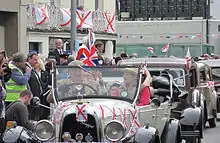
Aware of the military importance of Jersey, the British government had ordered that the bailiwick be heavily fortified. On 6 January 1781, a French invasion force of 2,000 men set out to take over the island, but only half of the force arrived and landed. The Battle of Jersey lasted about half an hour, with the English successfully defending the island. There were about thirty casualties on each side, and the English took 600 French prisoners who were subsequently sent to England. The French commanders were slain.
Trade laid the foundations of prosperity, aided by neutrality between England and France.[37] The Jersey way of life involved agriculture, milling, fishing, shipbuilding and production of woollen goods. 19th-century improvements in transport links brought tourism to the island.
During the Second World War, some citizens were evacuated to the UK but most remained. Jersey was occupied by Germany from 1 July 1940 until 9 May 1945, when Germany surrendered.[38] During this time the Germans constructed many fortifications using Soviet slave labour. After 1944, supplies from mainland France were interrupted by the D-Day landings, and food on the island became scarce. The SS Vega was sent to the island carrying Red Cross supplies and news of the success of the Allied advance in Europe. During the Nazi occupation, a resistance cell was created by communist activist Norman Le Brocq and the Jersey Communist Party, whose communist ideology of forming a 'United Front' led to the creation of the Jersey Democratic Movement.[39] The Channel Islands were one of the last places in Europe to be liberated. 9 May is celebrated as the island's Liberation Day, where there are celebrations in Liberation Square.
Throughout 2020 and the beginning of 2021, Jersey suffered from the global COVID-19 pandemic. The island was placed into a lockdown, with significant restrictions on freedom of movement for residents on 30 March.
Governance
Politics
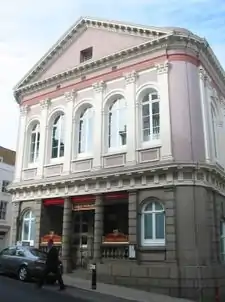
Jersey is a British Crown dependency and is not part of the United Kingdom - it is officially part of the British Islands. As one of the Crown dependencies, Jersey is autonomous and self-governing, with its own independent legal, administrative and fiscal systems.[40] Jersey's government has described Jersey as a "self-governing, democratic country with the power of self-determination".[41]
Because Jersey is a dependency of the British Crown, Queen Elizabeth II reigns in Jersey.[42] "The Crown" is defined by the Law Officers of the Crown as the "Crown in right of Jersey".[43] The Queen's representative and adviser in the island is the Lieutenant Governor of Jersey - Sir Stephen Dalton since 13 March 2017. He is a point of contact between Jersey ministers and the UK Government and carries out some functions in relation to immigration control, deportation, naturalisation and the issue of passports.[44]
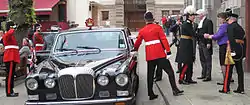
In 1973, the Royal Commission on the Constitution set out the duties of the Crown as including: ultimate responsibility for the 'good government' of the Crown dependencies; ratification of island legislation by Order in Council (Royal Assent); international representation, subject to consultation with the island authorities before concluding any agreement which would apply to them; ensuring the islands meet their international obligations; and defence.[45]
Legislature and government
Jersey's unicameral legislature is the States Assembly. It includes 49 elected members: 8 senators (elected on an island-wide basis), 12 Connétables (often called 'constables', heads of parishes) and 29 deputies (representing constituencies), all elected for four-year terms as from the October 2011 elections.[46] There are also five non-voting members appointed by the Crown: the Bailiff, the Lieutenant Governor of Jersey, the Dean of Jersey, the Attorney General and Solicitor General.[47] Jersey has one of the lowest voter turnouts internationally, with just 33% of the electorate voting in 2005, putting it well below the 77% European average for that year.[48]
The Council of Ministers, consisting of a Chief Minister and nine ministers, makes up part of the Government of Jersey.[49][50] Each minister may appoint up to two assistant ministers.[51] A Chief Executive is head of the civil service.[52] Some government functions are carried out in the island's parishes.
The Bailiff is President (presiding officer) of the States Assembly,[53] head of the judiciary and as civic head of the island carries out various ceremonial roles.
Law
Jersey is a distinct jurisdiction for the purposes of conflict of laws, separate from the other Channel Islands, England and Wales, Scotland and Northern Ireland.[54]
Jersey law has been influenced by several different legal traditions, in particular Norman customary law, English common law and modern French civil law.[55] Jersey's legal system is therefore described as 'mixed' or 'pluralistic', and sources of law are in French and English languages, although since the 1950s the main working language of the legal system is English.
The principal court is the Royal Court, with appeals to the Jersey Court of Appeal and, ultimately, to the Judicial Committee of the Privy Council. The Bailiff is head of the judiciary; the Bailiff and the Deputy Bailiff are appointed by the Crown. Other members of the island's judiciary are appointed by the Bailiff.
Parishes
Jersey is divided into twelve parishes (which have civil and religious functions). They are all named after their parish church. The Connétable is the head of the parish. They are elected at island general elections and sit ex oficio in the States Assembly.
The parishes have various civil administrative functions, such as roads (managed by the Road Committee) and policing (through the Honorary Police). Each parish is governed through direct democracy at Parish Assemblies, consisting of all eligible voters resident in the parish. The Procureurs du Bien Public are the legal and financial representatives of thes parishes.
The parishes of Jersey are further divided into vingtaines (or, in St. Ouen, cueillettes), divisions that are historic. Today they are used chiefly for purposes of local administration and electoral constituency.
External relations

The external relations of Jersey are overseen by the External Relations Minister of the Government of Jersey.[56][57] In 2007, the Chief Minister and the UK Lord Chancellor signed an agreement[18] that established a framework for the development of the international identity of Jersey.
Although diplomatic representation is reserved to the Crown. Jersey has been developing its own international identity over recent years. It negotiates directly with foreign governments on various matters, for example Tax information exchange agreements (TIEAs) have been signed directly by the island with several countries.[58][59] The Government maintains offices (some in partnership with Guernsey) in Caen,[60] London[61] and Brussels.[62]
Jersey is a member of the British-Irish Council, the Commonwealth Parliamentary Association and the Assemblée parlementaire de la Francophonie.
Jersey Independence has in the past been discussed in the States Assembly. Former External Relations Minister Sir Philip Bailhache has at various times warned that the island may need to go independent.[63] It is not Jersey Government policy to seek independence, but the island is prepared if it needed to do so.[64][65][66]
Relationship with the European Union
Jersey is a third-party European country to the EU. Its relationship with the EU operates under the free-trade agreement negotiated by the UK. Since 1 January 2021, Jersey has been part of the UK-EU Trade and Economic Cooperation Agreement for the purposes of goods and fishing. Goods exported from the island into Europe are not be subject to tariffs and Jersey is solely responsible for management of its territorial waters. Although there is no provision for services, the External Relations Minister Ian Gorst is confident it is compatible with pre-existing relationship. The deal was unanimously approved by the States Assembly.[67]
Before the end of the transition period after the UK withdrew from the EU in 2020, Jersey had a special relationship with the EU. Jersey was within the Union as a European Territory for whose external relationships the UK is responsible.[68] It was part of the EU customs union and the common external tariff applied. There was free movement of goods between Jersey and the EU but free movement of people did not apply to Jersey. Jersey was not part of the single market in financial services. It was not required to implement EU Directives on such matters as the movement of capital, company law or money laundering.
Under the EU trade deal, regarding fishing, Jersey takes control of all fishing boats in its waters through a licensing process, however EU boats with a history of fishing in Jersey waters will be granted a permit. Similarly, Jersey boats that have traditionally fished in French waters will be given a permit to continue by the French authorities.[69] The change means that Jersey will control fishing activities for EU boats in Jersey waters which is of concern especially to French fishermen.[70] Jersey boats registered with NEAFC can land crustaceans and fin fish they have caught at the ports of Carteret or Granville, as these species are exempt from the EU sanitary and phytosanitary (SPS) requirements for an Export Health Certificate, however specific French permission is required before each landing. Scallops, clams and whelks cannot be landed into the EU without a health certificate.[71]
COVID-19 pandemic
Jersey has been and continues to be affected by the ongoing global COVID-19 pandemic since 10 March 2020. The strategy combatting the pandemic is to "suppress, contain and shield",[72] involving suppressing outbreaks of the virus and protecting vulnerable islanders. There are no plans to aim for elimination of the virus.[73] At first, the strategy simply involved increased health and hygiene guidance, but the rising number of cases led to Jersey going into a lockdown on 30 March 2020.[74] Restrictions were eased according to the "Safe Exit" framework[75] from May.
As of February 2021, Jersey is undergoing a phased reopening after a 'circuit breaker' set of restrictions put in place to suppress the second wave of the virus as part of the Government winter strategy. In mid-November, the island saw a spike in new cases, so the Chief Minister introduced a mask mandate. Later on the 3 December and subsequently on the 26 December, a number of businesses were closed.[76] At present the island is in 'Stage 2' of reconnection. Schools and non-essential retail are open but all other businesses remain closed.[77][78]
There are severe travel restrictions into the Bailiwick for all travellers. The island operates a border testing programme, which normally organises countries and regions according to a 'traffic light' system and all arrivals undergo three swab tests in the first 10 days from their arrival.[79] Since 30 January 2021, all countries have been classed as 'red', requiring a minimum 10 days self-isolation for all arrivals.[80] All arrivals therefore became obligated to go into a ten-day self-isolation period, with the option to swab test on the day of arrival, the 5th day after arriving, and the 10th day.[81]
Geography
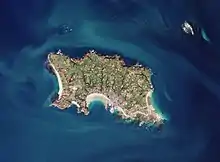
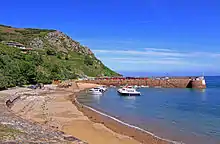
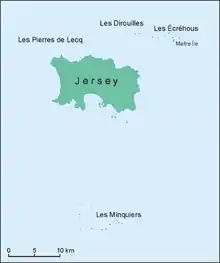
Jersey is an island measuring 118.2 square kilometres (45.6 sq mi) (or 66,436 vergées),[5] including reclaimed land and intertidal zone. It lies in the English Channel, about 12 nautical miles (22 km; 14 mi) from the Cotentin Peninsula in Normandy, France, and about 87 nautical miles (161 km; 100 mi) south of Great Britain.[82] It is the largest and southernmost of the Channel Islands and part of the British Isles, with a maximum land elevation of 143 m (469 ft) above sea level.
About 24% of the island is built-up. 52% of the land area is dedicated to cultivation and around 18% is the natural environment.[83]
It lies within longitude -2° W and latitude 49° N. It has a coastline that is 70 km long and a total area of 119 square kilometres. It measures roughly 9 miles from west to east and 5 miles north to south, which gives it the affectionate name among locals of "nine-by-five".
The island is divided into twelve parishes, the largest of which is St Ouen and the smallest of which is St Clement. The island is characetrised by a number of valleys which generally run north-to-south, such as Waterworks Valley, Grands Vaux, Mont les Vaux, although a few run in other directions, such as Le Mourier Valley. The highest point on the island is Les Platons at 136 m.[84]
There are several smaller island groups that are part of the Bailiwick of Jersey, such as Les Minquiers and Les Écrehous, however unlike the smaller islands of the Bailiwick of Guernsey, none of these are permanently inhabited.
Settlements
The 2011 Island Plan defines the island's built-up areas as three main entities.[85] The island is effectively a single conurbation, consisting of an urban core, suburbs and exurban rural communities.
The largest settlement is the town of St Helier, which also plays host to the island's seat of government. The town consists of the built-up area of southern St Helier, including First Tower, and some adjoining parts of St Saviour and St Clement, such as Georgetown. The town is the central business district, hosting a large proportion of the island's retail and employment, such as the finance industry.
The primary suburban areas of St Helier consist of the Five Oaks area in St Saviour, and developments along the coast, primarily along main roads to east and west of the town. The south and east coasts from St Aubin to Gorey are largely urbanised, with only small gaps in their development, such as the Royal Golf Course in Grouville.
Outside of the town, many islanders live in rural and village settlements and even the more rural areas of the island have considerable amounts of development (even St Ouen, the least densely populated parish still has 270 persons per square kilometre[86]). The most notable exurban development is the Les Quennevais area, which is home to a small precinct of shops, a park and a leisure centre. Many people in these communities regularly travel to St Helier for work and leisure purposes.
Most of the villages are the namesake settlement of their parish, for example St John's Village in St John, however some are not, such as Maufant Village on the border of St Saviour and St Martin.
The Jersey House Price Index has doubled between 2002 and 2020. The mix-adjusted house price for Jersey is £533,000, higher than any UK region including London.[87]
Climate
The climate is an oceanic climate with mild winters and mild to warm summers.[88]
The Atlantic Ocean has a moderating effect on temperature in Jersey, as water has a much greater specific heat capacity than air and tends to heat and cool slowly throughout the year. This has a warming influence on coastal areas in winter and a cooling influence in summer. The highest temperature recorded was 36.0 °C (96.8 °F) on 9 August 2003 and again on 23 July 2019,[89] and the lowest temperature recorded was −10.3 °C (13.5 °F) on 5 January 1894. By comparison, higher temperatures are found in mainland United Kingdom, which achieved 38.5 °C (101.3 °F) in Faversham, Kent on 10 August 2003. The impact of the Atlantic Ocean and coastal winds ensure that Jersey is slightly cooler than the southern and central parts of England during the summer months. Snow falls rarely in Jersey; some years will pass with no snow fall at all.
The terrain consists of a plateau sloping from long sandy bays in the south to rugged cliffs in the north. The plateau is cut by valleys running generally north–south.
The following table contains the official Jersey Airport averages for 1981-2010 for Jersey, being located 7.2 kilometres (4.5 mi) from St. Helier.
| Climate data for Jersey Airport, elevation 84m, 1981-2010 | |||||||||||||
|---|---|---|---|---|---|---|---|---|---|---|---|---|---|
| Month | Jan | Feb | Mar | Apr | May | Jun | Jul | Aug | Sep | Oct | Nov | Dec | Year |
| Record high °C (°F) | 14.0 (57.2) |
18.0 (64.4) |
20.3 (68.5) |
25.0 (77.0) |
28.0 (82.4) |
33.0 (91.4) |
36.0 (96.8) |
36.0 (96.8) |
30.2 (86.4) |
26.0 (78.8) |
21.0 (69.8) |
16.0 (60.8) |
36.0 (96.8) |
| Average high °C (°F) | 8.3 (46.9) |
8.4 (47.1) |
10.4 (50.7) |
12.5 (54.5) |
15.8 (60.4) |
18.4 (65.1) |
20.4 (68.7) |
20.6 (69.1) |
18.7 (65.7) |
15.4 (59.7) |
11.7 (53.1) |
9.2 (48.6) |
14.2 (57.6) |
| Daily mean °C (°F) | 6.3 (43.3) |
6.1 (43.0) |
7.9 (46.2) |
9.5 (49.1) |
12.6 (54.7) |
15.1 (59.2) |
17.2 (63.0) |
17.5 (63.5) |
15.8 (60.4) |
13.0 (55.4) |
9.6 (49.3) |
7.1 (44.8) |
11.5 (52.7) |
| Average low °C (°F) | 4.3 (39.7) |
3.8 (38.8) |
5.3 (41.5) |
6.5 (43.7) |
9.3 (48.7) |
11.8 (53.2) |
13.9 (57.0) |
14.3 (57.7) |
12.9 (55.2) |
10.6 (51.1) |
7.5 (45.5) |
5.0 (41.0) |
8.8 (47.8) |
| Record low °C (°F) | −10.3 (13.5) |
−9.0 (15.8) |
−3.3 (26.1) |
−1.6 (29.1) |
0.0 (32.0) |
5.9 (42.6) |
9.0 (48.2) |
7.7 (45.9) |
6.0 (42.8) |
−2.6 (27.3) |
−3.0 (26.6) |
−4.0 (24.8) |
−10.3 (13.5) |
| Average precipitation mm (inches) | 93.1 (3.67) |
68.9 (2.71) |
66.1 (2.60) |
56.4 (2.22) |
55.6 (2.19) |
47.5 (1.87) |
44.6 (1.76) |
49.5 (1.95) |
63.9 (2.52) |
103.4 (4.07) |
105.4 (4.15) |
111.3 (4.38) |
865.8 (34.09) |
| Mean monthly sunshine hours | 66.1 | 91.6 | 134.0 | 196.5 | 236.7 | 245.4 | 252.7 | 235.3 | 184.6 | 118.8 | 79.9 | 63.2 | 1,904.8 |
| Source: Met Office[90] and Voodoo Skies[91] | |||||||||||||
Economy

Jersey's economy is highly developed and dynamic, with a GDP per capita of £45,320[92] in 2019. It is a mixed market economy, with free market principles and an advanced social security infrastructure.[93] The officially currency in Jersey is the pound sterling, though it has its own banknotes and coins, known as the Jersey pound. Jersey's monetary policy is linked to the Bank of England.
Jersey is most notable economically for being one of the largest offshore finance centres. The United Kingdom acts as a conduit for financial services between European countries and the island.[94]
The economy of Jersey is based on financial services (40% of GVA in 2012), tourism and hospitality (hotels, restaurants, bars, transport and communications totalling 8.4% of GVA in 2012), retail and wholesale (7% of GVA in 2012), construction (6.2% of GVA in 2012) and agriculture (1.3% of GVA in 2012).[5]
Thanks to specialisation in a few high-return sectors, at purchasing power parity Jersey has high economic output per capita, substantially ahead of all of the world's large developed economies. Gross national income in 2009 was £3.7 billion (approximately £40,000 per head of population).[5] However, this is not indicative of each individual resident's purchasing power, and the actual standard of living in Jersey is comparable to that in the United Kingdom outside central London. The growth of this sector however has not been without its controversies as Jersey has been characterised by critics and detractors as a place in which the "leadership has essentially been captured by global finance, and whose members will threaten and intimidate anyone who dissents."[48] In June 2005 the States introduced the Competition (Jersey) Law 2005[95] to regulate competition and stimulate economic growth. This competition law was based on that of other jurisdictions. In 2015, Jersey (in conjunction with the Bailiwick of Gunersey) established the Channel Islands Financial Ombudsman (CIFO) to resolve consumer complaints about financial services provided in or from the Channel Islands[see www.ci-fo.org for details and legislative basis].
Tourism supports not only hotels, but also retail and services: in 2015 there were 717,600 visitors spending £243 million.[96] Duty-free goods are available for purchase on travel to and from the island.
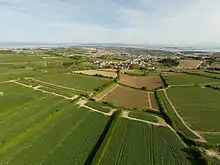
In 2017, 52% of the Island's area was agricultural land (a decrease since 2009).[83] Major agricultural products are potatoes and dairy produce; agriculture's share of GVA increased 5% in 2009, a fifth successive year of growth.[5] Jersey cattle are a small breed of cow widely known for its rich milk and cream; the quality of its meat is also appreciated on a small scale.[97][98] The herd total in 2009 was 5,090 animals.[5] Fisheries and aquaculture make use of Jersey's marine resources to a total value of over £6 million in 2009.[5]
Farmers and growers often sell surplus food and flowers in boxes on the roadside, relying on the honesty of customers to drop the correct change into the money box and take what they want. In the 21st century, diversification of agriculture and amendments in planning strategy have led to farm shops replacing many of the roadside stalls.
53,460 people were employed in Jersey as of December 2010: 24% in financial and legal services; 16% in wholesale and retail trades; 16% in the public sector; 10% in education, health and other private sector services; 10% in construction and quarrying; 9% in hotels, restaurants and bars.[5]
Jersey along with Guernsey has its own lottery called the Channel Islands Lottery that was launched in 1975.
On 18 February 2005, Jersey was granted Fairtrade Island status.[99]
Taxation
Jersey is not a tax-free jurisdiction. Taxes are levied on properties (known as 'rates') and a Personal Income Tax, Corporate Income Tax and goods and services tax exist.[100]
Before 2008, Jersey had no value-added tax. Many companies, such as Amazon and Play.com, took advantage of this and a loophole in European law, known as low-value consignment relief, to establish a tax-free fulfilment industry from Jersey.[101] This loophole was closed by UK authorities in 2012, leading to the closure of most of industry.[101]
There is a 20% standard rate for Income Tax and a 5% standard rate for GST. The island has a 0% default tax rate for corporations, however higher rates apply to financial services, utility companies and large corporate retailers.[100]
Jersey is considered to be a tax haven by some organisations - for example the Financial Secrecy Index ranks Jersey as 18th as of 2018.[102] Jersey does not feature, however, in the March 2019 revised EU list of non-cooperative jurisdictions for tax purposes.[103]
Transport

The primary mode of transport on the island is the motor vehicle. Jersey has a road network consisting of 557 km of roads and there are a total of 124,737 motor vehicles registered on the island as of 2016.[104]
There are no longer any railways on the island, however there used to be two main railway lines, the Jersey Western Railway and the Jersey Eastern Railway. The Western Railway track has been converted to a cycle track. Public transport in Jersey consists of a bus network. There is also a taxi network.
Jersey has a large network of lanes, some of which are classified as green lanes, which have a 15 mph speed limit and where priority is afforded to pedestrians, cyclists and horse riders.
Jersey has an airport and a number of ports, which are operated by Ports of Jersey.[105]
Currency

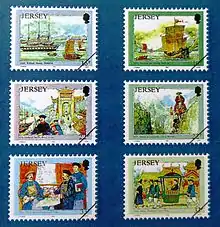
The official currency of Jersey is the pound sterling. Jersey issues its own postage stamps, banknotes (including a £1 note which is not issued in the UK) and coins that circulate alongside all other sterling coinage. Jersey currency is not legal tender outside Jersey; however it is acceptable tender[106] in the UK and can be surrendered at banks in exchange for UK currency. Due to French tourism, many places accept the euro.
In July 2014, the Jersey Financial Services Commission approved the establishment of the world's first regulated Bitcoin fund, at a time when the digital currency was being accepted by some local businesses.[107]
Demographics

Censuses have been undertaken in Jersey since 1821. In the 2011 census, the total resident population was estimated to be 97,857, of whom 34% live in Saint Helier, the island's only town.[108] Approximately half the island's population was born in Jersey; 31% of the population were born elsewhere in the British Isles, 7% in continental Portugal or Madeira, 8% in other European countries and 4% elsewhere.[109]
The people of Jersey are often called Islanders or, in individual terms, Jerseyman or Jerseywoman. Some Jersey-born people identify as British.
| Year | Pop. | ±% |
|---|---|---|
| 1871 | 56,627 | — |
| 1951 | 55,244 | −2.4% |
| 1961 | 59,489 | +7.7% |
| 1971 | 69,329 | +16.5% |
| 1981 | 76,050 | +9.7% |
| 1991 | 84,082 | +10.6% |
| 2001 | 87,186 | +3.7% |
| 2011 | 97,857 | +12.2% |
| 2019 | 106,800 | +9.1% |
| 2019 estimate[6] | ||
Immigration and nationality
Jersey employs a number of population controls on people moving to and from the island. Jersey is part of the Common Travel Area (CTA),[110] a border control-free zone which encompasses the Crown Dependencies, the United Kingdom and the Republic of Ireland. This means a passport is not required to travel from Jersey from any of these territories (or vice versa), though the Government recommends all travellers bring photo ID, since it may need to be checked by customs or police officers and is generally required by commercial transport providers into the island.[111] Due to the CTA, Jersey-born British citizens in the rest of the CTA and British and Irish citizens in Jersey have the right to access social benefits, access healthcare, access social housing support and to vote in general elections.[112] For non-CTA travel, Jersey maintains its own immigration[113] and border controls (although most travel into the Bailiwick is from the rest of the CTA), however United Kingdom immigration legislation may be extended to Jersey (subject to exceptions and adaptations) following consultation with Jersey and with Jersey's consent.[114]
The definition of "United Kingdom" in the British Nationality Act 1981 is interpreted as including the UK and the Islands together.[115] This means that for immigration and nationality purposes, the United Kingdom generally treats Jersey as though it were part of the UK. As such, there is no such thing as a 'Jersey passport'. British passports issued in Jersey are full British passports with the same design of and their holders enjoy the same rights as other British citizens will only be issued to British Jersey residents or Jersey-born British citizens and say "BRITISH PASSPORT BAILIWICK OF JERSEY".[116][117]
Jersey is constitutionally entitled to restrict immigration[118] by non-Jersey residents, but control of immigration at the point of entry cannot be introduced for British, certain Commonwealth and EEA nationals without change to existing international law.[119]
To control population, Jersey operates a system of registration which restricts the right to live and work in the island according to certain requirements. In order to move to Jersey or work in Jersey, everyone (including Jersey-born people) must be registered and have a registration card. There are a number of statuses:
| Requirements | Housing | Work | |
|---|---|---|---|
| Entitled | Most Jersey-born residents (permanently)
Long-term residents (at least 10 years) |
Can buy, sell or lease any property | Can work anywhere |
| Licensed | Certain essential workers | Can buy, sell or lease most property | Permission required |
| Entitled to work | Long-term residents (at least 5 years)
Spouse or civil partner of someone who is entitled to work or higher. |
Can lease 'registered' property | Can work anywhere |
| Registered | All others | Can lease 'registered' property | Permission required |
History of immigration
Historical large-scale immigration was facilitated by the introduction of steamships (from 1823). By 1840, up to 5,000 English people, mostly half-pay officers and their families, had settled in Jersey.[24] In the aftermath of 1848, Polish, Russian, Hungarian, Italian and French political refugees came to Jersey. Following Louis Napoléon's coup of 1851, more French proscrits arrived. By the end of the 19th century, well-to-do British families, attracted by the lack of income tax, were settling in Jersey in increasing numbers, establishing St Helier as a predominantly English-speaking town.
Seasonal work in agriculture had depended mostly on Bretons and mainland Normans from the 19th century. The growth of tourism attracted staff from the United Kingdom. Following liberation in 1945, agricultural workers were mostly recruited from the United Kingdom – the demands of reconstruction in mainland Normandy and Brittany employed domestic labour.
Until the 1960s, the population had been relatively stable for decades at around 60,000 (excluding the Occupation years). Economic growth spurred immigration and a rise in population, which is, by 2013, about 100,000. From the 1960s Portuguese workers arrived, mostly working initially in seasonal industries in agriculture and tourism.
Immigration has helped give aspects of Jersey a distinct urban character, particularly in and around the parish of St Helier, which contributes much to ongoing debates between development and sustainability throughout the island.[121]
Language
| Language | Main language | Secondary language | Total speakers |
|---|---|---|---|
| English | 82,349 | 3,443 | 85,792 |
| Portuguese | 4,002 | 3,300 | 7,305 |
| French | 338 | 14,776 | 15,114 |
| Jèrriais (Jersey French) | 113 | 2,761 | 2,874 |
| Other | 384 | 4,496 | 4,880 |
Religion
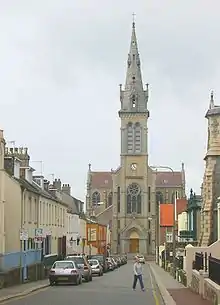
Religion in Jersey has a complex history, drawn largely from different Christian denominations. In 2015, Jersey's first ever national survey of religion found that two fifths of Jersey people have no religion, with only small handfuls of Jersey people belonging to the non-Christian religions. In total, 54% said they had some form of religion, and 7% were not sure. Of those that specified a denomination of Christianity, equal proportions were 'Catholic' or 'Roman Catholic' (43%) as were 'Anglican' or 'Church of England' (44%). The remaining eighth (13%) gave another Christian denomination.[122]
The established church is the Church of England, from 2015 under the See of Canterbury (previously under the Winchester diocese). In the countryside, Methodism found its traditional stronghold. A substantial minority of Roman Catholics can also be found in Jersey. There are two Catholic private combined primary and secondary schools: De La Salle College in Saint Saviour is an all-boys school, and Beaulieu Convent School in Saint Saviour is an all-girls school; and FCJ primary school in St. Saviour. A Catholic order of Sisters has a presence in school life.
Culture

Until the 19th century, indigenous Jèrriais – a variety of Norman – was the language of the island, though French was used for official business. During the 20th century, British cultural influence saw an intense language shift take place and Jersey today is predominantly English-speaking.[21] Jèrriais nonetheless survives; around 2,600 islanders (three percent) are reckoned to be habitual speakers, and some 10,000 (12 percent) in all claim some knowledge of the language, particularly amongst the elderly in rural parishes. There have been efforts to revive Jèrriais in schools, and the highest number of declared Jèrriais speakers is in the capital.

The dialects of Jèrriais differ in phonology and, to a lesser extent, lexis between parishes, with the most marked differences to be heard between those of the west and east. Many place names are in Jèrriais, and French and English place names are also to be found. Anglicisation of the place names increased apace with the migration of English people to the island.
Some Neolithic carvings are the earliest works of artistic character to be found in Jersey. Only fragmentary wall-paintings remain from the rich mediaeval artistic heritage, after the wholesale iconoclasm of the Calvinist Reformation of the 16th century.
The island is particularly famous for the Battle of Flowers, a carnival held annually since 1902.[123] Other festivals include La Fête dé Noué[124] (Christmas festival), La Faîs'sie d'Cidre (cidermaking festival),[125] the Battle of Britain air display, Jersey Live Music Festival, Branchage Film Festival, food festivals, and parish events.
The island's patron saint is Saint Helier.[126]
Broadcast

BBC Radio Jersey provides a radio service, and BBC Channel Islands News with headquarters in Jersey provides a joint television news service with Guernsey. ITV Channel Television is a regional ITV franchise shared with the Bailiwick of Guernsey but with its headquarters in Jersey.
Channel 103 is a commercial radio station. Bailiwick Radio broadcasts two music services, Classics and Hits, online at bailiwickradio.com, Apple & Android apps and on TuneIn. Radio Youth FM is an internet radio station run by young people.[127]
Bailiwick Express is one of Jersey's digital online news sources.
Daily newspaper
Jersey has only one newspaper, the Jersey Evening Post, which is printed six days a week, and has been in publication since 1890.
Music
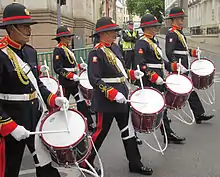
The traditional folk music of Jersey was common in country areas until the mid-20th century. It cannot be separated from the musical traditions of continental Europe, and the majority of songs and tunes that have been documented have close parallels or variants, particularly in France. Most of the surviving traditional songs are in French, with a minority in Jèrriais.
In contemporary music, Guru Josh was most notable for his internationally successful debut hit Infinity and its re-releases, reaching number one in numerous European countries. Furthermore, Nerina Pallot has enjoyed international success. Music festivals in Jersey include Jersey Live, Weekender, Rock in the Park, Avanchi presents Jazz in July, the music section of the Jersey Eisteddfod and the Liberation Jersey Music Festival.[129]
Cinema
In 1909, T. J. West established the first cinema in the Royal Hall in St. Helier, which became known as West's Cinema in 1923 (demolished 1977). The first talking picture, The Perfect Alibi, was shown on 30 December 1929 at the Picture House in St. Helier. The Jersey Film Society was founded on 11 December 1947 at the Café Bleu, West's Cinema. The large Art Deco Forum Cinema was opened in 1935 – during the German occupation this was used for German propaganda films.
The Odeon Cinema was opened 2 June 1952 and, was later rebranded in the early 21st century as the Forum cinema. Its owners, however, struggled to meet tough competition from the Cineworld Cinemas group, which opened a 10 screen multiplex on the waterfront centre in St. Helier on reclaimed land in December 2002 and the Odeon closed its doors in late 2008. The Odeon is now a listed building.[130][131]
Since 1997, Kevin Lewis (formerly of the Cine Centre and the New Forum) has arranged the Jersey Film Festival, a charity event showing the latest and also classic films outdoors in 35 mm on a big screen. The festival is regularly held in Howard Davis Park, St Saviour.
First held in 2008, the Branchage Jersey International Film Festival[132] attracts filmmakers from all over the world. The 2001 movie The Others was set on the island in 1945 shortly after liberation.
Food and drink

Seafood has traditionally been important to the cuisine of Jersey: mussels (called moules in the island), oysters, lobster and crabs – especially spider crabs – ormers and conger.
Jersey milk being very rich, cream and butter have played a large part in insular cooking. (See Channel Island milk) However, there is no indigenous tradition of cheese making, contrary to the custom of mainland Normandy, but some cheese is produced commercially. Jersey fudge, mostly imported and made with milk from overseas Jersey cattle herds, is a popular food product with tourists.
Jersey Royal potatoes are the local variety of new potato, and the island is famous for its early crop of Chats (small potatoes) from the south-facing côtils (steeply sloping fields). They were originally grown using vraic as a natural fertiliser giving them their own individual taste, only a small portion of those grown in the island still use this method. They are eaten in a variety of ways, often simply boiled and served with butter or when not as fresh fried in butter.
Apples historically were an important crop. Bourdélots are apple dumplings, but the most typical speciality is black butter (lé nièr beurre), a dark spicy spread prepared from apples, cider and spices. Cider used to be an important export. After decline and near-disappearance in the late 20th century, apple production is being increased and promoted. Besides cider, apple brandy is produced. Other production of alcohol drinks includes wine,[133] and in 2013 the first commercial vodkas made from Jersey Royal potatoes were marketed.[134]
Among other traditional dishes are cabbage loaf, Jersey wonders (les mèrvelles), fliottes, bean crock (les pais au fou), nettle (ortchie) soup, vraic buns.
Sport
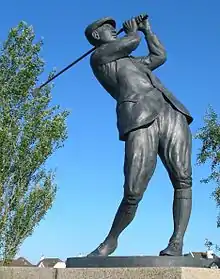
In its own right Jersey participates in the Commonwealth Games and in the biennial Island Games, which it first hosted in 1997 and more recently in 2015.[135]
In sporting events in which Jersey does not have international representation, when the British Home Nations are competing separately, islanders that do have high athletic skill may choose to compete for any of the Home Nations – there are, however, restrictions on subsequent transfers to represent another Home Nation.
Jersey is an associate member of the International Cricket Council (ICC). The Jersey cricket team plays in the Inter-insular match among others. The Jersey cricket team competed in the World Division 4, held in Tanzania in October 2008, after recently finishing as runners-up and therefore being promoted from the World Division 5 held in Jersey. They also competed in the European Division 2, held in Guernsey during August 2008. The youth cricket teams have been promoted to play in the European Division 1 alongside Ireland, Scotland, Denmark, the Netherlands and Guernsey. In two tournaments at this level Jersey have finished 6th.
For Horse racing, Les Landes Racecourse can be found at Les Landes in St. Ouen next to the ruins of Grosnez Castle.
The Jersey Football Association supervises football in Jersey. The Jersey Football Combination has nine teams in its top division. Jersey national football team plays in the annual Muratti competition among others.
Rugby union in Jersey comes under the auspices of the Jersey Rugby Association (JRA), which is a member of the Rugby Football Union of England. Jersey Reds compete in the English rugby union system;[136] after four promotions in five seasons, the last three of which were consecutive, they competed in the second-level RFU Championship in 2012–13.[137]
Jersey has two public indoor swimming pools. Swimming in the sea, windsurfing and other marine sports are practised. Jersey Swimming Club have organised an annual swim from Elizabeth Castle to Saint Helier Harbour for over 50 years. A round-island swim is a major challenge that a select number of swimmers have achieved. The Royal Channel Island Yacht Club is based in Jersey.
There is one facility for extreme sports and some facilities for youth sports. Jersey has one un-roofed skateboarding park. Coastal cliffs provide opportunities for rock climbing.
Two professional golfers from Jersey have won the Open Championship seven times between them; Harry Vardon won six times and Ted Ray won once. Vardon and Ray also won the U.S. Open once each. Harry Vardon's brother, Tom Vardon, had wins on various European tours.
An independent body that promotes sports in Jersey and support clubs, 'Jersey Sport' was launched in 2017[138]
Literature
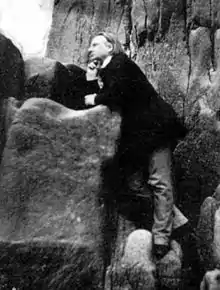
Wace, a Norman poet of the 12th century, is Jersey's earliest known author. Printing arrived in Jersey only in the 1780s, but the island supported a multitude of regular publications in French (and Jèrriais) and English throughout the 19th century, in which poetry, most usually topical and satirical, flourished (see Jèrriais literature). The first Jèrriais book to be published was Rimes et Poésies Jersiaises de divers auteurs réunies et mises en ordre, edited by Abraham Mourant in 1865. Writers born in Jersey include Elinor Glyn, John Lemprière, Philippe Le Sueur Mourant, Robert Pipon Marett and Augustus Asplet Le Gros. Frederick Tennyson and Gerald Durrell were among authors who made Jersey their home. Contemporary authors based in Jersey include Jack Higgins.
Education
Schools
The Government of Jersey provides education through state schools (including a fee-paying option at secondary level) and also supports private schools. The Jersey curriculum follows that of England.[22] It follows the National Curriculum although there are a few differences to adapt for the island,[139] for example all Year 4 students study a six-week Jersey Studies course.[140]
Further and higher education
Jersey has a college of further education and university centre, Highlands College. As well as offering part-time and evening courses, Highlands is also a sixth form provider, working alongside Hautlieu School which offers the only non-fee-paying sixth form, and works collaboratively with a range of organisations including the Open University, University of Plymouth and London South Bank University. In particular students can study at Highlands for the two-year foundation degree in financial services and for a BSc in social sciences, both validated by the University of Plymouth.
The Institute of Law is Jersey's law school, providing a course for students seeking to qualify as Jersey advocates and solicitors. It also provides teaching for students enrolled on the University of London LLB degree programme, via the International Programmes. The Institute of Law also runs a 'double degree' course: students can obtain the LLB from the University of London and a Licence en droit M1 from Toulouse 1 Capitol University; the two combine 4 years of studies in both English and French. The Open University supports students in Jersey, but they pay higher fees than UK students. Private sector higher education providers include the Jersey International Business School.
Environment
| Designations | |
|---|---|
| Official name | South East Coast of Jersey, Channel Islands |
| Designated | 10 November 2000 |
| Reference no. | 1043[141] |
Three areas of land are protected for their ecological or geological interest as Sites of Special Interest (SSI). Jersey has four designated Ramsar sites: Les Pierres de Lecq, Les Minquiers, Les Écréhous and Les Dirouilles and the south east coast of Jersey (a large area of intertidal zone).[142]
Jersey is the home of the Jersey Zoo (formerly known as the Durrell Wildlife Park[143]) founded by the naturalist, zookeeper and author Gerald Durrell.
Biodiversity
Four species of small mammal are considered native:[144] the wood mouse (Apodemus sylvaticus), the Jersey bank vole (Myodes glareolus caesarius), the Lesser white-toothed shrew (Crocidura suaveolens) and the French shrew (Sorex coronatus). Three wild mammals are well-established introductions: the rabbit (introduced in the mediaeval period), the red squirrel and the hedgehog (both introduced in the 19th century). The stoat (Mustela erminea) became extinct in Jersey between 1976 and 2000. The Green lizard (Lacerta bilineata) is a protected species of reptile; Jersey is its only native habitat in the British Isles.[145]
The red-billed chough Pyrrhocorax pyrrhocorax became extinct in Jersey around 1900, when changes in farming and grazing practices led to a decline in the coastal slope habitat required by this species. Birds on the Edge, a project between the Government of Jersey, Durrell Wildlife Conservation Trust and Jersey National Trust, is working to restore Jersey's coastal habitats and reinstate the red-billed chough (and other bird species) to the island[146]
Jersey is the only place in the British Isles where the agile frog Rana dalmatina is found.[147] The remaining population of agile frogs on Jersey is very small and is restricted to the south west of the island. The species is the subject of an ongoing programme to save it from extinction in Jersey via a collaboration between the Government of Jersey, Durrell Wildlife Conservation Trust and Jersey Amphibian and Reptile Group (JARG), with support and sponsorship from several other organisations. The programme includes captive breeding and release, public awareness and habitat restoration activities.[148]
Trees generally considered native are the alder (Alnus glutinosa), silver birch (Betula pendula), sweet chestnut (Castanea sativa), hazel (Corylus avellana), hawthorn (Crataegus monogyna), beech (Fagus sylvatica), ash (Fraxinus excelsior), aspen (Populus tremula), wild cherry (Prunus avium), blackthorn (Prunus spinosa), holm oak (Quercus ilex), oak (Quercus robur), sallow (Salix cinerea), elder (Sambucus nigra), elm (Ulmus spp.) and medlar (Mespilus germanica). Among notable introduced species, the cabbage palm (Cordyline australis) has been planted in coastal areas and may be seen in many gardens.[149]
Notable marine species[150] include the ormer, conger, bass, undulate ray, grey mullet, ballan wrasse and garfish. Marine mammals include the bottlenosed dolphin[151] and grey seal.[152]
Historically the island has given its name to a variety of overly-large cabbage, the Jersey cabbage, also known as Jersey kale or cow cabbage.[153]
Japanese Knotweed Fallopia japonica is an invasive species that threatens Jersey's biodiversity.[154] It is easily recognisable and has hollow stems with small white flowers that are produced in late summer.[155] Other non-native species on the island include the Colorado beetle, burnet rose and oak processionary moth.[154]
Public services
Emergency services
Emergency services[156] are provided by the States of Jersey Police with the support of the Honorary Police as necessary, States of Jersey Ambulance Service,[157] Jersey Fire and Rescue Service[158] and the Jersey Coastguard.[159] The Jersey Fire and Rescue Service and the Royal National Lifeboat Institution operate an inshore rescue and lifeboat service; Channel Islands Air Search provides rapid response airborne search of the surrounding waters.[160]
The States of Jersey Fire Service was formed in 1938 when the States took over the Saint Helier Fire Brigade, which had been formed in 1901. The first lifeboat was equipped, funded by the States, in 1830. The RNLI established a lifeboat station in 1884.[161] Border security and customs controls are undertaken by the States of Jersey Customs and Immigration Service. Jersey has adopted the 112 emergency number alongside its existing 999 emergency number.
Supply services
Water supplies in Jersey are managed by Jersey Water. Jersey Water supply water from two water treatment works, around 7.2 billion litres in 2018. Water in Jersey is almost exclusively from rainfall-dependent surface water. The water is collected and stored in six reservoirs and there is also a desalination plant that produces up to 10.8 million litres per day (around half of the Island's average daily usage). In 2017, 101 water pollution incidents were reported, an increase of 5% on 2016. Another estimated 515,700 m3 of water is abstracted for domestic purposes from private sources (around 9% of the population).[162]
Electricity in Jersey is provided by a sole supplier, Jersey Electricity, of which the States of Jersey is the majority shareholder.[163] Jersey imports a large amount of its power. Jersey Electricity claims the carbon intensity of its electricity supply is 35g CO2 e / kWh compared to 352g CO2 e / kWh in the UK. 35% of Jersey's imported power comes from hydro-electric sources and 65% from nuclear sources.[164]
Notable people
See also
Footnotes and references
- The largest settlement on Jersey is in fact made up of parts of various parishes and is often referred to as "town" by islanders.
- Saint Helier is the de facto capital of Jersey, being the seat of the island's government, however Government House, the official royal residence of the island, is located in Saint Saviour
- Jersey does not have a de jure official language, but these are the permitted languages in the island's parliament, the States Assembly "P.4/2018 - Jèrriais: Optional use in the States Chamber" (PDF). States of Jersey Greffe. 15 January 2018. Cite journal requires
|journal=(help)
- "Anthem for Jersey". Government of Jersey.
- "Bulletin 2: Place of birth, ethnicity, length of residency, marital status" (PDF). Government of Jersey. Retrieved 12 September 2013.
- Jersey Annual Social Survey: 2015 (PDF). States of Jersey. p. 8. Retrieved 2 December 2015.
- "Members". statesassembly.gov.je. Retrieved 14 January 2020.
- "Jersey in Figures 2013 booklet" (PDF). Government of Jersey. Retrieved 1 January 2015.
- "Jersey's population increases by 1100 in the last year". ITV. 18 June 2020. Retrieved 18 June 2020.
- "Measuring Jersey's Economy" (PDF). Government of Jersey. 28 September 2016. Retrieved 8 January 2017.
- "National accounts: GVA and GDP". Statistics Jersey. 2019. Retrieved 4 January 2021.
- "Filling Gaps in the Human Development Index" (PDF). United Nations ESCAP. February 2009. Archived from the original (PDF) on 5 October 2011.
- "Facts about Jersey". Government of Jersey.
- "Where is Jersey". Jersey Tourism. Archived from the original on 20 August 2006. Retrieved 15 October 2006.
- "Les Écrehous & Les Dirouilles, Jersey". Ramsar Sites Information Service. Retrieved 25 April 2018.
- "Les Minquiers, Jersey". Ramsar Sites Information Service. Retrieved 25 April 2018.
- "Les Pierres de Lecq". Ramsar Sites Information Service. Retrieved 25 April 2018.
- House of Commons Justice Committee (30 March 2010). Crown dependencies. 8th Report of Session 2009–10 (HC 56-1 ed.). The Stationery Office Ltd. ISBN 978-0-215-55334-8.
- "COMMON POLICY FOR EXTERNAL RELATIONS" (PDF). Government of Jersey. Retrieved 8 December 2012.
- "Crown Dependencies". Royal.gov.uk. Retrieved 15 October 2020.
- "Framework for developing the international identity of Jersey" (PDF). Government of Jersey. Retrieved 12 September 2013.
- "Civil Unreported Templates". Statesassembly.gov.je. Archived from the original on 11 May 2011. Retrieved 31 May 2011.
- "Jersey's relationship with the UK and EU". Government of Jersey. Gov.je. Retrieved 2 November 2016.
- "Facts about Jersey". Government of Jersey. 30 November 2015.
- "Understanding the curriculum". Government of Jersey. 30 November 2015.
- Dominique Fournier, Wikimanche.
- Marguerite Syvret; Joan Stevens (1998). Balleine's History of Jersey. La Société Jersiaise. ISBN 1-86077-065-7.
- "The Duke of York's Release to John Lord Berkeley, and Sir George Carteret, 24th of June, 1664". avalon.law.yale.edu. 18 December 1998. Retrieved 22 September 2011.
- "So what's all this stuff about Nova Caesarea??". avalon.law.yale.edu. Retrieved 22 September 2011.
- "Jersey", Concise Dictionary of World Place-Names. John Everett-Heath. Oxford University Press 2005. Oxford Reference Online. Oxford University Press. Jersey Library. 6 October 2006
- Lepelley, René (1999). Noms de lieux de Normandie et des îles Anglo-Normandes. Paris: Bonneton. ISBN 2862532479.
- "Old Norse Words in the Norman Dialect". Viking Network. Archived from the original on 15 November 2018. Retrieved 30 August 2016.
- "Countryside Character Appraisal – Character Area A1: North Coast Heathland". States of Jersey. Archived from the original on 19 March 2016. Retrieved 6 October 2006.
- "A Short Constitutional History of Jersey". Voisin & Co. 18 May 1999. Archived from the original on 26 August 2007. Retrieved 7 October 2006.
- Liddicoat, Anthony (1 August 1994). A Grammar of the Norman French of the Channel Islands. Walter de Gruyter. p. 6. ISBN 3-11-012631-1.
- Syvret, Marguerite (2011). Balleine's History of Jersey. The History Press. pp. 50–1. ISBN 978-1860776502.
- Ommer, Rosemary E. (1991). From Outpost to Outport. McGill-Queen's University Press. pp. 13–14. ISBN 0-7735-0730-2.
- Weeks, Daniel J. (1 May 2001). Not for Filthy Lucre's Sake. Lehigh University Press. p. 45. ISBN 0-934223-66-1.
- Cochrane, Willard W. (30 September 1993). The Development of American Agriculture. University of Minnesota Press. p. 18. ISBN 0-8166-2283-3.
- Ommer, Rosemary E. (1991). From Outpost to Outport. McGill-Queen's University Press. p. 12. ISBN 0-7735-0730-2.
- Bellows, Tony. "What was the "Occupation" and why is "Liberation Day" celebrated in the Channel Islands?". Société Jersiaise. Retrieved 18 August 2013.
- Meddick, Simon; Payne, Liz; Catz, Phil (2020). Red Lives: Communists and the Struggle for Socialism. UK: Manifesto Press Cooperative Limited. pp. 122–123. ISBN 978-1-907464-45-4.
- House of Commons, Justice Committee (23 March 2010). Crown dependencies (PDF). 8th Report of Session 2009–10. London: The Stationery Office. ISBN 978-0-215-55334-8.
- Brexit Information Report (PDF) (Report). Jersey: States Greffe. 27 June 2016. Retrieved 6 January 2021.
- Jersey Law Review. "Lé Rouai, Nouot' Duc". Archived from the original on 16 October 2014. Retrieved 12 October 2014.
- "Public Hearing – Review of the Roles of the Crown Officers" (PDF). 20 July 2010. Archived from the original (PDF) on 12 August 2011.
- Office of the Lieutenant Governor. "Lieutenant-Governor". Archived from the original on 12 August 2011. Retrieved 22 August 2011.
- Royal Commission on the Constitution 1969–1973 (1973). Report. Part XI of Volume 1. London.
- "States of Jersey (Miscellaneous Provisions) Law 2011". Jerseylaw.je. 2 August 2011. Archived from the original on 22 October 2013. Retrieved 12 September 2013.
- "States of Jersey Law 2005, Article 1". Jerseylaw.je. 5 May 2006. Archived from the original on 3 October 2011. Retrieved 12 September 2013.
- Shaxson, N. (2011). Treasure islands: Tax havens and the men who stole the world. London: The Bodley Head.
- "Council of Ministers adopts 'Government of Jersey' identity". Government of Jersey. Retrieved 9 February 2019.
- "States of Jersey Law 2005, Article 18". Jerseylaw.je. 5 May 2006. Archived from the original on 3 October 2011. Retrieved 12 September 2013.
- "States of Jersey Law 2005, Article 24". Jerseylaw.je. 5 May 2006. Archived from the original on 3 October 2011. Retrieved 12 September 2013.
- States of Jersey Official Report, 3 May 2011, 5.1. Statement by the Chief Minister regarding the appointment of a new Chief Executive to the Council of Ministers.
- "States of Jersey Law 2005, Article 3". Jerseylaw.je. 5 May 2006. Archived from the original on 3 October 2011. Retrieved 12 September 2013.
- Collins of Mapesbury, Lord; More; McLean; Briggs; Harris; McLachlan (2010). Dicey, Morris & Collins on the Conflict of Laws (14th ed.). London: Sweet & Maxwell. ISBN 978-1-84703-461-8.
- See generally S Nicolle (2009). The Origin and Development of Jersey law: an Outline Guide (5th ed.). St Helier: Jersey and Guernsey Law Review. ISBN 978-0-9557611-3-3. and "Study Guide on Jersey Legal System and Constitutional Law". Jersey: Institute of Law. Archived from the original on 28 December 2013.
- "Meet our new foreign minister « This Is Jersey". Thisisjersey.com. Archived from the original on 17 January 2011. Retrieved 12 September 2013.
- "A new role of great importance". Thisisjersey.com. 17 January 2011. Archived from the original on 22 January 2011. Retrieved 12 September 2013.
- "TAX INFORMATION EXCHANGE AGREEMENTS (TIEAs)" (PDF). Government of Jersey. Retrieved 6 November 2011.
- "Jersey threatens to break with UK over tax backlash". the Guardian. 26 June 2012. Retrieved 21 January 2021.
- "The Office | Bureau des Îles Anglo-Normandes". Retrieved 21 January 2021.
- "Government of Jersey London Office | Representing Jersey in the UK". Government of Jersey London Office. 27 March 2017. Retrieved 21 January 2021.
- "Channel Islands Brussels Office (CIBO)". Channel Islands Brussels Office (CIBO). Retrieved 21 January 2021.
- Targett, Tania. "Independence 'may be only option if Brexit deal is bad'". jerseyeveningpost.com. Retrieved 21 January 2021.
- "COMMON POLICY FOR EXTERNAL RELATIONS" (PDF). States of Jersey. Retrieved 8 December 2012.
- "Jersey Independence 'Not Government Policy'". Channel 103. Retrieved 21 January 2021.
- Second Interim Report of the Constitution Review Group (States Greffe, Jersey) http://www.statesassembly.gov.je/display_result.asp?url=\documents\reports\46527-24954-2762008.htm%5B%5D
- Express, Bailiwick. "Jersey signs up to Brexit trade deal". Bailiwick Express. Retrieved 27 December 2020.
- "WRITTEN QUESTION P-3620/02 by Wolfgang Ilgenfritz (NI) to the Commission. Position of Jersey in the EU". EUR-Lex. Retrieved 2 November 2016.
- "Jersey fishermen 'not celebrating' Brexit deal". BBC. 29 December 2020.
- https://www.leparisien.fr/economie/brexit-les-pecheurs-francais-empeches-d-acceder-aux-eaux-de-jersey-15-01-2021-8419425.php
- "Direct landing of fish to the EU from 1 January 2021". States of Jersey. Retrieved 16 January 2021.
- "Jersey's COVID-19 Winter Strategy". Government of Jersey. Retrieved 21 January 2021.
- "Cautious reopening required but no elimination strategy, Chief Minister says". jerseyeveningpost.com. Retrieved 25 January 2021.
- "'Stay at Home': Advice for Islanders". gov.je. 29 March 2020. Retrieved 29 March 2020.
- "Safe Exit Framework" (PDF). Government of Jersey. Retrieved 21 January 2021.
- "Covid: Jersey to enter 'hospitality circuit breaker'". BBC News. 3 December 2020.
- "COVID-19 update - process for reconnecting". Government of Jersey. 7 January 2021. Retrieved 21 January 2021.
- "All Jersey retailers can reopen from today". ITV News. 18 May 2020. Retrieved 8 February 2021.
- "Travelling to Jersey (safer travel guidance)". Government of Jersey. Retrieved 21 January 2021.
- Morris, Michael. "Guernsey put on 'amber' travel list as border restrictions are tightened". jerseyeveningpost.com. Retrieved 21 January 2021.
- "Guernsey moved to red under Jersey travel rules following increase in cases". ITV News. 30 January 2021. Retrieved 3 February 2021.
- Geographically it is not part of the British Isles. As of 15 October 2006, the States of Jersey indicates that the island is situated "only 22 km off the northwest coast of France and 140 km south of England".
- Jersey. Government of Jersey https://www.gov.je/Government/JerseyInFigures/Environment/Pages/SizeLandCover.aspx. Retrieved 10 December 2020. Missing or empty
|title=(help) - "Les Platons (Jersey) | Channel Islands". UK mountain Guide. Retrieved 10 December 2020.
- "States of Jersey - Revised 2011 Island Plan". consult.gov.je. Retrieved 10 December 2020.
- "Jersey Census 2001: Chapter 2: Population Characteristics" (PDF). States of Jersey. Retrieved 15 November 2018.
- "Jersey House Price Index Q3 2020" (PDF). Government of Jersey.
- "CIA – The World Factbook – Jersey". Central Intelligence Agency. 5 October 2006. Retrieved 7 October 2006.
- "Synop report summary". ogimet.com. Retrieved 7 April 2020.
- "Jersey Climate Normals 1981–2010". Met Office. May 2015. Retrieved 8 May 2015.
- "Jersey Climate Extremes". Voodoo Skies. October 2015. Archived from the original on 4 March 2016. Retrieved 8 October 2015.
- "National accounts: GVA and GDP". Statistics Jersey. 2019. Retrieved 4 January 2021.
- "Benefits and financial support". Government of Jersey. Retrieved 5 January 2021.
- Garcia-Bernardo, Javier; Fichtner, Jan; Takes, Frank W.; Heemskerk, Eelke M. (24 July 2017). "Uncovering Offshore Financial Centers: Conduits and Sinks in the Global Corporate Ownership Network". Scientific Reports. 7 (1): 6246. arXiv:1703.03016. Bibcode:2017NatSR...7.6246G. doi:10.1038/s41598-017-06322-9. ISSN 2045-2322. PMC 5524793. PMID 28740120.
- "Competition (Jersey) Law 2005" (PDF). Jcra.je. Archived from the original (PDF) on 14 June 2007. Retrieved 16 August 2013.
- "Tourism statistics". Government of Jersey. Retrieved 18 October 2017.
- Davenport, Philippa (20 May 2006). "Jersey's cash cow". Financial Times. Retrieved 7 October 2006.
- Witmer, Jason (11 June 2004). "CROPP contracts brings profitability to Ohio grass-based, organic dairies". The Rodale Institute. Retrieved 7 October 2006.
- "Island achieves Fairtrade status". BBC News. 24 February 2005. Retrieved 6 October 2006.
- "Moving to Jersey: Money and tax". Government of Jersey. Retrieved 2021-02-12. Check date values in:
|access-date=(help) - "EU to close LVCR loophole completely". jerseyeveningpost.com. Retrieved 12 January 2021.
- "View 2018 Results". financialsecrecyindex.com. Retrieved 1 May 2019.
- "EUR-Lex - 52019XG0326(01) - EN - EUR-Lex". eur-lex.europa.eu. Retrieved 2 May 2019.
- "Registered vehicles (FOI)". Government of Jersey. Retrieved 10 December 2020.
- "A brief history of Ports of Jersey". www.ports.je. Retrieved 10 December 2020.
- Department of the Official Report (Hansard), House of Lords (6 December 2001). "Lords Hansard text for 6 Dec 2001 (211206-28)". Publications.parliament.uk. Retrieved 31 May 2011.
- "Jersey approve Bitcoin fund launch on island". BBC news. Retrieved 10 July 2014.
- "Jersey Census 2011 Bulletin no 1" (PDF). States of Jersey. December 2011.
- "Jersey Census 2011 Bulletin no 2" (PDF). States of Jersey. January 2012.
- "Visas / entry clearances / work permit issue". Home Affairs, Customs & Immigration, Immigration. States of Jersey. Archived from the original on 10 October 2007. Retrieved 14 September 2009.
Passengers arriving from outside of the Common Travel Area (United Kingdom, Republic of Ireland, Channel Islands and the Isle of Man) will pass through an Immigration control.
- "Moving to Jersey: Customs and immigration". Government of Jersey. Retrieved 30 January 2021.
- Citizensinformation.ie. "Common Travel Area between Ireland and the United Kingdom". www.citizensinformation.ie. Retrieved 30 January 2021.
- "gov.je – Immigration". Archived from the original on 19 March 2016. Retrieved 7 April 2020.
- Department of the Official Report (Hansard), House of Lords. "Answer by Parliamentary Under-Secretary of State, Home Office, (Lord West of Spithead) in UK House of Lords 18 January 2010". Publications.parliament.uk. Retrieved 31 May 2011.
- "British Nationality Act 1981". Legislation, UK, Acts. Office of Public Sector Information. Archived from the original on 1 October 2009. Retrieved 14 September 2009.
the Islands” means the Channel Islands and the Isle of Man; [...] the United Kingdom” means Great Britain, Northern Ireland and the Islands, taken together;
- Government of Jersey [@GovJersey] (15 June 2020). "twitter.com/govjersey/status/1272536695678873600" (Tweet) – via Twitter.
- "Jersey Citizens Advice - Passports ( 2.7.1. )". www.cab.org.je. Retrieved 30 January 2021.
- "gov.je – Summary Policy" (PDF). Archived from the original (PDF) on 7 April 2016. Retrieved 7 April 2020.
- "gov.je – Migration Monitoring and Regulation" (PDF). Archived from the original (PDF) on 19 March 2016. Retrieved 7 April 2020.
- "Residential and employment statuses and what they mean". Government of Jersey. Retrieved 30 January 2021.
- Johnson, Henry (2016) Encountering Urbanization on Jersey: Development, Sustainability, and Spatiality in a Small Island Setting. Urban Island Studies.
- "Jersey Annual Social Survey: 2015" (PDF). States of Jersey. p. 8. Retrieved 2 December 2015.
- "The Jersey Battle of Flowers". Jersey Battle of Flowers Association. 2005. Archived from the original on 25 August 2006. Retrieved 15 October 2006.
- "La Fête dé Noué". Archived from the original on 22 December 2010. Retrieved 18 September 2011.
- "La Faîs'sie d'Cidre". Retrieved 18 September 2011.
- Falle, Samuel. "Saint Helier – Saint Hélyi – Saint Hélier". Geraint Jennings, Société Jersiaise. Archived from the original on 14 December 2004. Retrieved 15 October 2006.
- http://www.facebook.com/pg/RadioYouthFM/about
- "Band of the Island of Jersey". Archived from the original on 7 September 2011. Retrieved 18 September 2011.
- "Liberation Jersey Music Festival". Retrieved 18 September 2011.
- "Historic Document Reference : HE0024". Mygov.je. Archived from the original on 16 October 2015. Retrieved 16 August 2013.
- "Former Odeon Cinema Building sold to Freedom Church Jersey". Archived from the original on 2 December 2012.
- "Branchage Film Festival". Archived from the original on 15 September 2011. Retrieved 18 September 2011.
- "La Mare Wine Estate". Retrieved 28 August 2013.
- "Double vodka on the Rock". Jersey Evening Post. 1 June 2013. Archived from the original on 10 September 2013. Retrieved 28 August 2013.
- "Island Games Jersey 2015 Bid | Home". Jersey2015.com. Archived from the original on 25 March 2012. Retrieved 26 April 2012.
- "Jersey Rugby Football Club". Jrfc.je. Archived from the original on 8 September 2015. Retrieved 26 April 2012.
- Pryor, Tim (23 April 2012). "Jersey promoted: The rise and rise of an island side". BBC Radio Jersey. BBC Sport. Retrieved 13 May 2012.
- "New body to promote sport". jerseyeveningpost.com. Retrieved 23 April 2019.
- "Understanding the curriculum". Government of Jersey. Retrieved 17 July 2017.
- "L'Office du Jèrriais". jerriais.org.je. Retrieved 17 July 2017.
- "South East Coast of Jersey, Channel Islands". Ramsar Sites Information Service. Retrieved 25 April 2018.
- "Protected Coastlines (Ramsar)". Government of Jersey. 2016. Retrieved 28 June 2016.
- "Time to be a zoo again". Durrell.
- "Species Based Research Projects – The Jersey Mammal Survey". Archived from the original on 19 March 2016. Retrieved 7 April 2020.
- "Biodiversity Action Plan" (PDF). Archived from the original (PDF) on 7 April 2016. Retrieved 7 April 2020.
- "Birds on the Edge Project". Retrieved 28 June 2016.
- "Agile frog protection plans". Government of Jersey. 2016. Retrieved 28 June 2016.
- "Agile frog". Durrell Wildlife Conservation Trust. Archived from the original on 6 January 2009. Retrieved 28 June 2016.
- Trees in Jersey, The Jersey Association of Men of the Trees, Jersey 1997, ISBN 0-9530979-0-0
- "A-Z of Fish". Jersey.com. 21 August 2008. Archived from the original on 24 November 2010. Retrieved 31 May 2011.
- (PDF). 19 March 2016 https://web.archive.org/web/20160319021443/http://www.gov.je/NR/rdonlyres/49F2D9D7-2E1A-4958-9446-F3ADC2672868/0/Keithspaper.pdf. Archived from the original (PDF) on 19 March 2016. Missing or empty
|title=(help) - (PDF). 19 March 2016 https://web.archive.org/web/20160319023500/http://www.gov.je/NR/rdonlyres/27F0C1B6-73B4-4B51-A743-7000AEEAC404/0/CZMTPMarineBiodiversityOct05.pdf. Archived from the original (PDF) on 19 March 2016. Missing or empty
|title=(help) - "Giant cabbage « Jersey Evening Post". Jerseyeveningpost.com. Archived from the original on 6 June 2014. Retrieved 3 June 2014.
- Barnsley, S; Cary, E; Pienkowski, M; Wensink, C (2016). Measures of performance by 2016 of UK Overseas Territories and Crown Dependencies in implementing the 2001 Environment Charters or their equivalents and moving towards the Aichi Targets and Sustainable Development Targets (PDF) (First ed.). UK Overseas Territories Conservation Forum. pp. 97, 480. ISBN 978-1-911097-03-7. Retrieved 5 July 2016.
- "Japanese knotweed". Government of Jersey. Retrieved 5 July 2016.
- Archived 19 March 2016 at the Wayback Machine
- "Contacts". Gov.je. Retrieved 31 May 2011.
- "Jersey Fire and Rescue Service". Gov.je. Retrieved 31 May 2011.
- "Jersey Coastguard". Portofjersey.je. Archived from the original on 2 June 2011. Retrieved 31 May 2011.
- Ivor Bisson (3 February 2011). "CI Air Search Home page". Ci-airsearch.com. Retrieved 31 May 2011.
- "St Helier History". Rnli.org.uk. 14 December 1982. Retrieved 12 July 2012.
- Water statistics Government of Jersey Accessed on 14/12/2020
- "Key facts | Jersey Electricity". www.jec.co.uk. Retrieved 14 December 2020.
- "The stats behind the network: a review of Jersey Electricity in numbers over the past 12 months | Jersey Electricity". www.jec.co.uk. Retrieved 14 December 2020.
Further reading
- Balleine's History of Jersey, Marguerite Syvret and Joan Stevens (1998) ISBN 1-86077-065-7
- Jersey Through the Centuries, Leslie Sinel, Jersey 1984, ISBN 0-86120-003-9
- A Biographical Dictionary of Jersey, G.R. Balleine
Archaeology
- The Archaeology of the Channel Islands. Vol. 2: The Bailiwick of Jersey by Jacquetta Hawkes (1939)
- The Prehistoric Foundations of Europe to the Mycenean Age, 1940, C. F. C. Hawkes
- Jersey in Prehistory, Mark Patton, 1987
- The Archaeology and Early History of the Channel Islands, Heather Sebire, 2005.
- Dolmens of Jersey: A Guide, James Hibbs (1988).
- A Guide to The Dolmens of Jersey, Peter Hunt, Société Jersiaise, 1998.
- Statements in Stone: Monuments and Society in Neolithic Brittany, Mark Patton, 1993
- Hougue Bie, Mark Patton, Warwick Rodwell, Olga Finch, 1999
- The Channel Islands, An Archaeological Guide, David Johnston, 1981
- The Archaeology of the Channel Islands, Peter Johnston, 1986
Cattle
- One Hundred Years of the Royal Jersey Agricultural and Horticultural Society 1833–1933. Compiled from the Society's Records, by H.G. Shepard, Secretary. Eric J. Boston. Jersey Cattle, 1954
Religion
- The Channel Islands under Tudor Government, A.J. Eagleston
- Reformation and Society in Guernsey, D.M. Ogier
- International Politics and the Establishment of Presbyterianism in the Channel Islands: The Coutances Connection, C.S.L. Davies
- Religion, History and G.R. Balleine: The Reformation in Jersey, by J. St John Nicolle, The Pilot Magazine
- The Reformation in Jersey: The Process of Change over Two centuries, J. St John Nicolle
- The Chroniques de Jersey in the light of contemporary documents, BSJ, AJ Eagleston
- The Portrait of Richard Mabon, BSJ, Joan Stevens
External links
- gov.je Official Government of Jersey website
- Visit Jersey Government owned tourism website
- Jerripedia Online history and family history encyclopedia
- Vote.je Elections in Jersey
- Jersey. The World Factbook. Central Intelligence Agency.
- Locate Jersey
- Jersey, from the BBC News
- Jersey Evening Post
- Prehistoric Jersey
- JerseyShops.co.uk Archived 3 June 2019 at the Wayback Machine - local retailers
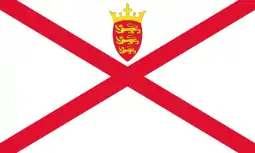
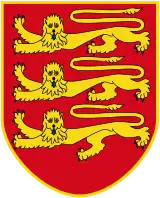
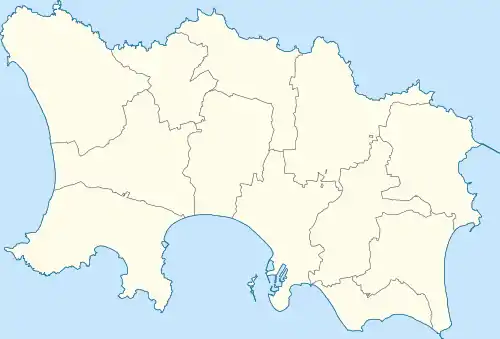
Countries.png.webp)